 |
|
Istanbul Archaeology Museums
consist of three museums. Those are Archaeology Museum, Old
Eastern Works Museum and Enameled Kiosk Museum. Istanbul
Archaeology Museums, which were established as Muze-i
Humayun (Empire Museum) by the famous artist and museum
director Osman Hamdi Bey at the end of the 19th century,
were opened to public on June 13, 1891. Besides its
importance as the "first Turkish museum", it has an
importance and specialty of being one of the |
|
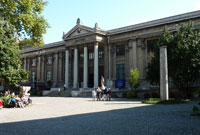 |
|
museum buildings that are
constructed as a Museum in the World. Today, it still
protects its outstanding place in the World's biggest
museums with its works more than a million belonging to
various cultures.
In the museum collections, there are rich and very important
works of art belonging to various civilizations from the
regions from Balkans to Africa, from Anatolia and
Mesopotamia to Arab Peninsula and Afghanistan that were in
the borders of the Ottoman Empire. |
|
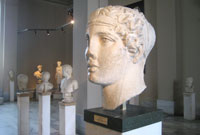 |
|
Archaeology Museum
The Archaeology Museum consists of two separate buildings.
I) Main Building (Old Building)
Its construction was started in 1881 by Osman Hamdi Bey and
with the additions in 1902 and 1908 it gained its latest
form. Its architect is Alexander Vallaury. The outer |
|
face of the building was made by
inspiring from the Iskender Tomb
and Crying Women tombs. It is a beautiful example of
neoclassical buildings in Istanbul. On the upper floor of
the two storey building there are small stone works, pots
and pans, small terracotta statues, the Treasure Department
and approximately 800.000 Ottoman coins, seals, decorations,
medals and Non-Muslim and Muslim Coin Cabinets, in which
coin moulds were kept, and a Library with approximately
70.000 books.
On the bottom floor saloons of the building, famous tombs
are displayed such as Iskender Tomb, Crying Women Tomb,
Satrap Tomb, Lykia Tomb, Tabnit Tomb that are in the Sayda
king graveyard.
On the bottom floor, besides the display of tombs, there is
Old Age Statuary display in which statues and reliefs from
important antic cities and regions are displayed. In this
display, the development of the art of statuary from the
Archaic Period to the Byzantium Period is displayed in
chronological order with outstanding examples. |
|
II) Additional Building (New
Building)
The additional building attached
to the southeast of the main building is of 6 storeys. There
are depots in the two storeys under the ground floor. The
four storeys of the building are arranged as exhibition
saloons. There is an inscription "Istanbul for Ages" on the
first floor of the building, "Anatolia and Troia for Ages"
on the second floor and "Surrounding Cultures of Anatolia:
Cyprus, Syria-Palestine" on the top floor. There is Infant
Museum and |
|
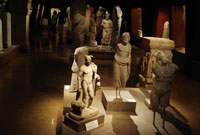 |
|
works display on the first floor of the additional building.
The Thrakia-Bithynia and Byzantium display saloon, which was
opened in August 1998, can be visited on the floor with the
name of "Surrounding Cultures of Istanbul".
The museum has received the European Council Museum Award in
1991, which is its 100. Establishment Anniversary, with the
new arrangement made in the lower floor saloons and the
Additional Building display. |
|
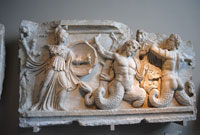 |
|
The Old Eastern Works Museum
The building, which was built by
Osman Hamdi Bey in 1883 as Sanayi-i Nefise (Fine Arts
School), was organized as a museum with the works made
between 1917-1919 and 1932-1935. The building, which was
closed for visits in 1963, was reopened again in 1974 with a
new display by changing the inner parts. On the upper floor
of the two-storey building, Anatolian, Mesopotamian,
Egyptian and Arabic works of art are displayed. |
|
|
Statue of Naramsin, the king of
Akad, the Kades Agreement and Zincirli statue are the unique
works of art in the museum. Moreover, in this museum there
is a "Tablet Archive" in which 75.000 documents with
cuneiform writings are kept. |
|
Enameled Kiosk Museum
The kiosk that has been made by
Fatih Sultan Mehmet in 1472 is one of the oldest examples of
Ottoman civil architecture in Istanbul. It has been used as
Muze-i Humayun (Empire Museum) in between 1875-1891. It was
opened to public in 1953 with the name of Fatih Museum where
Turkish and Islamic works of art were displayed and it was
transferred to Istanbul Archaeology Museums due to its site. |
|
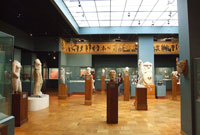 |
|
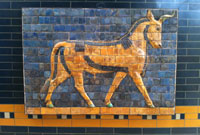 |
|
The entrance facade of the kiosk
is single-flat and the back facade is of two-storeyed. There
is a marble porch of 14 columns in the entrance. The
entrance exedra is decorated with mosaic enamels. Various
chinaware and ceramics from the Seljuk and Ottoman period
are displayed in the Kiosk that consists of 6 rooms and a
middle saloon. There are approximately 2000 works of art in
the museum and its depots. |
|
|
 |
|
|
|